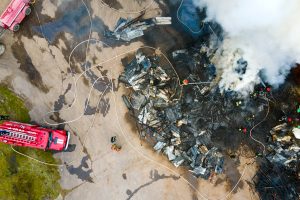The Texas Panhandle is grappling with the largest wildfire in its history, a disaster that has already claimed lives, homes, businesses, and thousands of cattle. As rain and snow bring a glimmer of hope for relief, the aftermath of these wildfires presents a significant challenge for homeowners and public adjusters alike. Understanding the extent of property damage and navigating the complexities of insurance claims will be crucial in the recovery efforts.
Table of contents
The Devastation of Texas Wildfires
In recent days, the state of Texas has faced an unprecedented challenge as wildfires rage across its northern Panhandle. The scale of this catastrophe cannot be overstated, with up to 500 homes and businesses reduced to ashes and at least two lives tragically lost to the inferno. Among the victims were Cindy Owen, 44, and Joyce Blankenship, 83, whose deaths remind us of the human toll behind the statistics.
The fires have scorched more than 1.1 million acres of land, an expanse five times larger than New York City, leaving behind a scarred landscape. The Smokehouse Creek wildfire, the largest wildfire in Texas history, stands as a stark symbol of this devastation. Despite the valiant efforts of firefighters, it has been contained by only 37%. This figure underscores the magnitude of the challenge emergency services are facing, battling not only the flames but also the harsh conditions fueling them.
Moreover, thousands of cattle, integral to the region’s economy and livelihood of many, have either perished in the fires or had to be euthanized due to injuries. This loss adds another layer of economic hardship to the already dire situation, affecting not just the immediate area but the broader agricultural community in Texas.
Impact on Homeowners
For homeowners in the fire’s path, the devastation extends far beyond the immediate destruction of property. The emotional and psychological impact of losing one’s home, often containing a lifetime of memories, cannot be understated. Communities that once thrived are now facing the daunting task of starting over from the ashes. The journey towards recovery will be long and arduous, filled with uncertainty and the daunting task of rebuilding what was lost.
Navigating the aftermath will require homeowners to deal with complex insurance claims, a process that can be overwhelming and fraught with difficulties. Understanding the nuances of their policies and what is covered under ‘sudden and accidental damage’ becomes crucial in such times. Moreover, some may find themselves embroiled in legal battles to secure the necessary support for rebuilding, adding to the stress and emotional toll of the situation.
Public adjusters play a critical role in this scenario, offering much-needed guidance and advocacy for homeowners as they navigate the intricate process of insurance claims. Their expertise can help ensure that homeowners are fairly compensated, enabling them to focus on the road to recovery. For public adjusters, the Texas wildfires represent not just a professional challenge but an opportunity to provide meaningful support to those affected, helping them rebuild their lives and homes amidst the aftermath of such a widespread disaster.
The Texas wildfires serve as a sobering reminder of the power of nature and the importance of preparedness, support systems, and the resilience of communities in the face of adversity. For homeowners and public adjusters alike, the path forward is fraught with challenges, but also with the possibility of renewal and rebuilding.
Role of Public Adjusters
This is where public adjusters step in. In the wake of such widespread destruction, public adjusters are more important than ever. They advocate for homeowners, ensuring that insurance companies provide fair and just compensation for the losses incurred.
Public adjusters will need to meticulously document the damage, differentiate between the direct impact of the wildfires and secondary damage (such as water damage from firefighting efforts), and negotiate with insurance providers to cover the costs of rebuilding and repairs.
Key Considerations for Homeowners and Adjusters
- Documentation: It’s crucial to document all damages thoroughly, taking pictures and noting any losses for insurance claims.
- Policy Review: Homeowners should review their insurance policies to understand what is covered under “fire damage” and any potential exclusions.
- Professional Assistance: Engaging a public adjuster can help homeowners navigate the complex claims process, ensuring they receive the maximum compensation available.
- Community Support: The importance of community support cannot be overstated. From emergency housing to fundraising efforts, community solidarity will be a cornerstone of the recovery process.
Conclusion
The Texas wildfires serve as a stark reminder of nature’s force and the fragility of our homes and communities. For those affected, the journey ahead will require resilience, patience, and support—from family, neighbors, and professionals like public adjusters. This tragedy also underscores the importance of being prepared, understanding one’s insurance coverage, and knowing who to turn to when disaster strikes.
As Texas begins to heal and rebuild, the role of public adjusters in advocating for homeowners will be vital in navigating the aftermath of these devastating wildfires.
FAQ
The northern Panhandle of Texas has been significantly impacted, with over 1.1 million acres burned, including homes, businesses, and agricultural land.
Homeowners should document all damages, review their insurance policies for fire damage coverage, and consider hiring a public adjuster to navigate the claims process effectively.
Public adjusters advocate for homeowners, ensuring they receive fair compensation from insurance companies for the wildfire damages, and help differentiate between direct and secondary damages in claims.
Yes, homeowners should be aware of direct fire damage, secondary water damage from firefighting, and possible structural weaknesses resulting from the intense heat.
Homeowners should act as soon as possible to document the damage and file a claim, ensuring they comply with their policy’s deadlines and maximize their potential compensation.
Communities can offer emergency housing, fundraising, emotional support, and resources for rebuilding efforts, highlighting the importance of solidarity in recovery.




